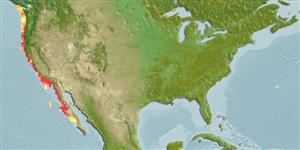Common names from other countries
>
Eupercaria/misc (Various families in series Eupercaria) >
Sciaenidae (Drums or croakers)
Etymology: Genyonemus: Greek, geny, -yos = face, jaw + Greek, nema = filament (Ref. 45335).
More on author: Ayres.
Environment: milieu / climate zone / depth range / distribution range
Ecologia
marino benthopelagico; distribuzione batimetrica ? - 183 m (Ref. 2850), usually ? - 30 m (Ref. 2850). Subtropical; 49°N - 24°N, 129°W - 111°W
Eastern Pacific: Canada (Barkley Sound in British Columbia) to Mexico (southern Baja California; rare north of California, USA.
Length at first maturity / Size / Peso / Age
Maturity: Lm 14.0, range 13 - 15 cm
Max length : 41.0 cm TL maschio/sesso non determinato; (Ref. 2850); Età massima riportata: 15 anni (Ref. 56049)
Short description
Chiavi di identificazione | Morfologia | Morfometria
Spine dorsali (totale) : 13 - 16; Raggi dorsali molli (totale) : 21 - 24; Spine anali: 2; Raggi anali molli: 11 - 12; Vertebre: 25. Pelvic fins with fleshy appendage at base, first ray with free thread-like tip.
Found over sandy bottoms (Ref. 9118). Feed on polychaetes, small shrimps, crabs and mollusks (Ref. 9118). Oviparous, multiple pelagic spawner (Ref. 51256).
A multiple spawner (Ref. 51256).
Eschmeyer, W.N., E.S. Herald and H. Hammann, 1983. A field guide to Pacific coast fishes of North America. Boston (MA, USA): Houghton Mifflin Company. xii+336 p. (Ref. 2850)
IUCN Red List Status (Ref. 130435)
CITES (Ref. 128078)
Not Evaluated
Threat to humans
Harmless
Human uses
Pesca: scarso interesse commerciale; Pesce da pesca sportiva: si
Strumenti
Special reports
Download XML
Fonti Internet
Estimates based on models
Preferred temperature (Ref.
115969): 7.7 - 18.1, mean 10.7 (based on 104 cells).
Phylogenetic diversity index (Ref.
82804): PD
50 = 1.0000 [Uniqueness, from 0.5 = low to 2.0 = high].
Bayesian length-weight: a=0.01023 (0.00561 - 0.01865), b=3.09 (2.94 - 3.24), in cm Total Length, based on LWR estimates for this species & (Sub)family-body (Ref.
93245).
Trophic level (Ref.
69278): 3.4 ±0.49 se; based on food items.
Resilienza (Ref.
120179): Medio, tempo minimo di raddoppiamento della popolazione 1.4 - 4.4 anni (tm=1; tmax = 15; Min batch fecundity = 800).
Fishing Vulnerability (Ref.
59153): Low to moderate vulnerability (31 of 100).
Climate Vulnerability (Ref.
125649): Low to moderate vulnerability (29 of 100).
